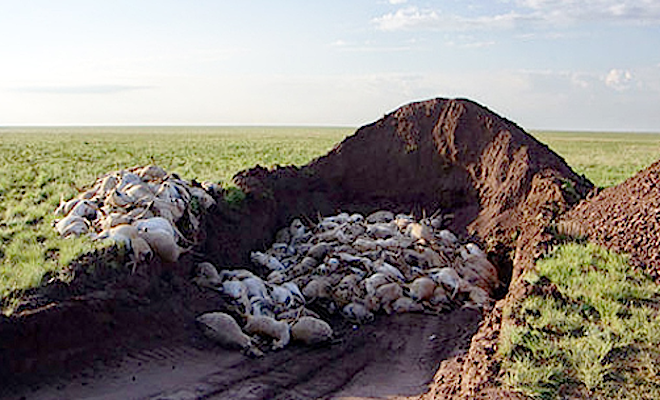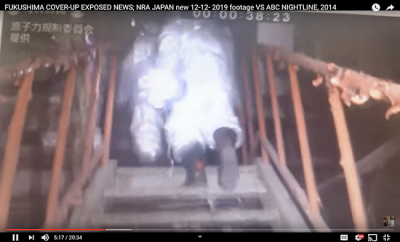
Geo Watch
What Killed 200,000+ Saiga Antelopes in Central Kazakhstan?
What Has Killed Nearly A Quarter Million Saiga Antelopes Since May 2015 in Central Kazakhstan?
byLinda Moulton Howe, Earthfiles:
“Our monitoring showed that the morbidity to be 100%.
Now that in a biological system is almost unique. This is certainly unusual. It doesn’t make a lot of biological sense.”
– Richard Kock, VMD., Royal Veterinary College, London

A burial pit for some of the 120,000 Saiga antelope adults and calves that rapidly died in May 2015, in central Kazakhstan. Image © 2015 by Sergei Khomenko/ U.N. FAO.

Remaining Saiga antelope distribution of some 50,000 on Earth are in Kalmykia, Russia (far left); Ural, Ustiurt and Betpak-dala, Kazakhstan (three middle purple regions); and Shargyn Gobi and Mankhan, Mongolia (far right).
September 25, 2015 London, England – On Wednesday, September 23rd, Pope Francis spoke at the White House about his concerns for our warming planet. He said, “Accepting the urgency, it seems clear to me that climate change is a problem which can no longer be left to a future generation.”
Nine of the ten hottest months on record have happened since 2005 and July 2015 was the hottest month for the world since NOAA began keeping records in 1880. The Earth’s warmest year on record was 2014, and the globally averaged sea surface temperature in 2014 was the highest on record. So far, oceans have absorbed over 90% of Earth’s excess heat from the growing accumulation of greenhouse gases in our planet’s atmosphere.
But scientists now warn that ocean absorption is slowing down, which means atmospheric warming will accelerate from anthropogenic factors. Those are human-produced greenhouse gasses from cars and industries around the world.
What is becoming more clear to doctors and veterinarians are the impacts that warming temperatures can have on bacteria such as changing their shape and chemical signals that could make them more toxic, even more lethal. That is now one of the medical speculations about the mysterious cause of two huge die-offs of Saiga antelope in May and September 2015 in central Khazakhstan.
Royal Veterinary College Professor Richard Kock, who has been at the center of the Saiga die-off investigation, wonders if two strains of bacteria found in the dead antelopes were impacted by warmer temperatures that might have changed the bacterias’ toxicity. Dr. Kock emphasized that at least 120,000 adults and calves all died together rapidly in May. He says that number is probably low to the actual total. In another Khazakhstan region 60,000 more all died within four days during the first week of September, a 100% morbidity that he thinks might be unique in the history of ruminant animals.
 Critically endangered Saiga antelope (Saiga tatarica) are hooved ruminants with distinctive
Critically endangered Saiga antelope (Saiga tatarica) are hooved ruminants with distinctive
long, flexible noses that hang down over their mouths. Image by WWF.
Saiga are horned antelope that have long, flexible noses, which hang down over their mouths, filtering out dust in the summer and heating frigid air for breathing in the winter. From the beginning of the Pleistocene more than 2 million years ago (2,588,000 to 11,700 years ago), Saiga lived in a huge territory that stretched from Mongolia to Europe and in parts of North America. When modern humans came into their territories, uncontrolled hunting for their meat and the demand by Chinese medicine for the Saiga horns caused the antelope population to collapse. There have been some recoveries. But in 1988 in Kazakhstan, there was a huge die-off similar to those in 2015. Pasteurella bacteria were found in those dead bodies and veterinarians assumed that was the cause of death without much investigation. By 1995, there was an estimated million Saiga left, mostly in Khazakhstan.












